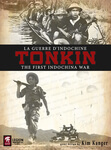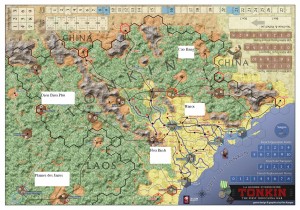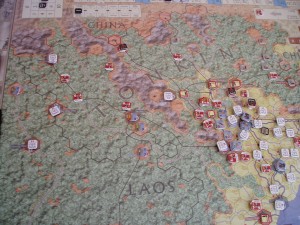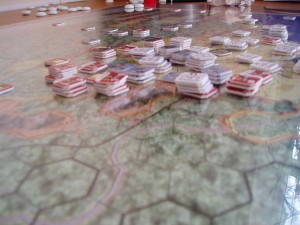Introduction
In the late 19th century, what is today known as Vietnam, was, together with Cambodia and Laos, forged into the French colony named Union Indochinoise. This conglomerate of countries was going to be ruled by France until the fifties of the 20th century. During this period, different groups from inside and outside Indochina tried to seize power of some parts of the territory. One of these was Japan, which occupied Indochina in March 1945. The Viet Minh, led by Ho Chi Minh, allied with the US to fight the Japanese and in August 1945, Ho Chi Minh proclaimed independence. However, after this victory, Vietnam was essentially split in two between the Chinese occupying the North to disarm the remaining Japanese, and the British, who had to collaborate with the Japanese to fight insurgents in the South. France succeeded in re-establishing its colonial hold on South Vietnam and the French returned to Saigon in September 1945. China and Britain subsequently handed Vietnam back to the French. Over the next decade, the Viet Minh and France fought over the rule in Vietnam until the battle of Dien Bien Phu in 1954, which ended in a devastating defeat for the French, brought about the end of French rule in Vietnam and the division of the country into South Vietnam (capital Saigon, led by Ngo Dihn Diem) and North Vietnam (capital Hanoi, led by Ho Chi Minh). In this first post, I will look at Tonkin. Dien Bien Phu wil follow later. The American involvement in Vietnam will be covered in a third post.
Conflict in Tonkin
 The last years of the French colonial power in North Vietnam and their fight against the Viet Minh is simulated in the game Tonkin by Kim Kanger, published by Legion Wargames. This strategic/operational game takes the player through the years 1950 to 1954 in five consecutive scenarios which can be played separately or as a campaign. Each game turn represents one month of real time and can be played in around 45 minutes.
The last years of the French colonial power in North Vietnam and their fight against the Viet Minh is simulated in the game Tonkin by Kim Kanger, published by Legion Wargames. This strategic/operational game takes the player through the years 1950 to 1954 in five consecutive scenarios which can be played separately or as a campaign. Each game turn represents one month of real time and can be played in around 45 minutes.
Scenarios, narrative and gameplay
The game consists of five scenarios, played on one map, which comprises Tonkin, parts of Laos and China. The scenarios depict pivotal moments in the four-year of indepence which culminated in the battle of Dien Bien Phu. The players start out with the fight for Cao Ban and the disaster of Route Colonial 4 (China had started to supply the Viet Minh in that area), then move into the delta in the battle of Hanoi, followed by the retaliation of the French and their reconquest of Hoa Binh. After Hoa Binh had fallen to the Viet Minh again, the French moved back into the delta. As a result, general Giap turned West to invade the Highlands, which led to the battle between the Clear River and the Red River. General Giap failed to defeat the French in this clash and moved into Laos, the French then stopped the Viet Minh outside Luang Prabang in what became known as the battle of les Plaines des Jarres (which is the fourth scenario in the game). After this defeat, the Viet Minh withdrew from Laos and finally attacked the heavily fortified air strip of Dien Bien Phu. Dien Bien Phu in the far West of Tonkin was so far away from the delta that the French planes could hardly make the roundtrip from the supply centres in the East. The French heavily entrenched several hundreds of elite units including the Foreign Legion and many Vietnamese conscripts. However, the Viet Minh managed to take Dien Bien Phu after several days and this total defeat of their troops led to the final retreat of the French from the region.

The players can choose to play the French side or the side of the Viet Minh. The scenarios follow one another and can be played separately, each with a new set-up, which can be either “historical”, i.e. choosing the correct divisions, battalions etc. that were deployed in the fifties, or “generic”, i.e. choosing the type of units that were deployed (so, you would choose one unit of paratroopers and deploy them but not necessarily the one belonging to the division that was historically deployed). Seeing as historical accuracy to that level of detail is of no interest to me personally, I am happy about this option because it speeds up setup considerably.

During the setup-phase, troops and supply dumps are deployed as well as two political objective markers, one is a rumour and worthless if captured, one gives 5 victory points to the Viet Minh. The first marker is put into a hex of historical importance in the scenario (for example the hex of Hoa Binh in the third scenario). The second one is placed by the Viet Minh player based on certain criteria. Additionally, victory points are won by the Viet Minh for dominating 10 or more settlements in the delta or 20 or more settlements in the Highlands. Whenever this balance shifts during the game, the victory points are either awarded or subtracted. Other ways for the Viet Minh to gain victory points are:
- Deployment of French reinforcements (so the French player has to weigh carefully whether bringing in troops will actually help him more than it will help the enemy)
- Elimination of French units
- Capturing victory point hexes currently occupied by the French
The French, on the other hand, gain victory points if:
- They capture victory point hexes currently occupied by the Viet Minh
- The Viet Minh lose 10 steps
The victory points need to be tracked in real time as the victory point level directly impacts the Viet Minh’s ability to bring in reinforcements.
The two sides have different abilities they bring to the game:
The French
- Have a navy which can attack coastal areas and transport troops
- Can use air transport for moving troops and supplies
- Have tanks and boats
- Can use air strikes
- Have more reinforcements and replacement points
The Viet Minh
- Can ambush
- Can deploy Tieu Doan in the heartland of occupied French zones and infiltrate the area
- Can invoke Bolshevik Spirit, which gives them a positive DRM in battle
- Generally move faster around the board
The game is played in phases: Reinforcement, Movement, Attrition, Operations (which again is divided into subphases), Supply. The Viet Minh player always goes first in these phases. Combat is possible during the movement phase in the form of overruns and in the operations phase as overruns, “normal combat”; air strikes, and barraging. During the Reinforcement phase, players can get supply dumps, replacement points to replace steps as well as bring in reinforcements as per the reinforcement chart. The Viet Minh can also “recruit” Tieu Doan if certain criteria are met. Movement is done based on terrain charts, and double-movement is possible under certain circumstances. In the attrition phase, out-of-supply units may lose steps. The operations phase is, in my opinion, the heart of the game and a mechanic I really like. The players get up to 8 different possible operations on which they can spend their operations points (each side gets 10 such points). These include: movement, combat, air strike, building of roads, organising disorganised units, building trenches. At the beginning of the operations phase, each player rolls 1d6. The result is divided by the two. The resulting number is the number of operations points the player gets to spend in a row. This is a nice change to the pace of the initiative in the game, which always lies with the Viet Minh as they go first in all phases. So, it could be that in the operations phase, the Viet Minh start off and can only spend one point, i.e. perform one action, and then the French can get up to three actions in a row. This leads to a constant ebb and flow of actions on both sides and allows for a lot of nice tactical bargaining. Once the points have been spent, each side rolls 1d6 again and goes through their points. This is repeated until both players have used up their 10 points.
The game ends when the last round of the scenario has been played or if one of the knock-out criteria has been met: the capture of the Viet Minh or French HQs, the capture of Hanoi by the Viet Minh. If the scenario ends normally on a time-out, the victory points are calculated and then compared to the victory point chart for that particular scenario.
Musings on the game
This was my first operational game of this depth, up till then, I had only played tactical games (Infidel, Ran, Caesar – CoG) and one operational game with less diverse mechanics (but no less fun!), namely Panzergruppe Guderian. Whenever I play a game, I start researching the historical side it tries to simulate and by playing the game and through my research, I usually get a much better insight into the relevant narrative being implemented. I would say that, from my point of view, the game mechanics simulate the historical situation very well: the infiltrative (to coin a word) nature of Viet Minh warfare is taken care of, as well as the supply problems the French faced (in the beginning of the game, the French player gets negative DRMs during battle due to the inferior quality of weaponry they were using at the time). The pacing of the game is excellent, the tactical and strategic choices are meaningful and make me think about my next move between turns even when I am not playing (always a good sign). The fact that in a strategic game, there would be months of inertia where the enemies are in a holding pattern also comes out in the gameplay. There were certain operation phases when either side just “passed” because the opponent’s positions were essentially unassailable.
All in all, I really like this game and can recommend it as a good solo-experience of medium complexity for players interested in this historical chapter of Indochina.

Sources:
http://en.wikipedia.org/wiki/French_Indochina
http://en.wikipedia.org/wiki/Ho_Chi_Minh
http://en.wikipedia.org/wiki/North_Vietnam
http://www.boardgamegeek.com/boardgame/70532/tonkin-the-indochina-war-1950-54-second-edition
http://www.legionwargames.com/legion_tonkin.html
Videos about game-play etc: http://www.youtube.com/playlist?list=PL155OUfKUUeF_bv6XN3HYzQz0aCSmAv90
Nicely done. Thanks for doing this for us.
I was actually looking into this game a week or two ago, so your review is very helpful for me.
Nice post! That dice roll for operation phase mechanic gives an interesting choice in that if you have a ‘perfect plan’ that needs three ops spent on it you might never be able to do it if you roll low. Whereas if you break up your spending the other side gets a chance to interfere in the middle of it.
Yes Gesine did a bang up job on this. I am hoping that she will write an entire series on all the Vietnam Era titles she has acquired.